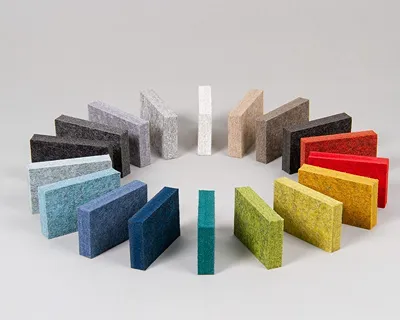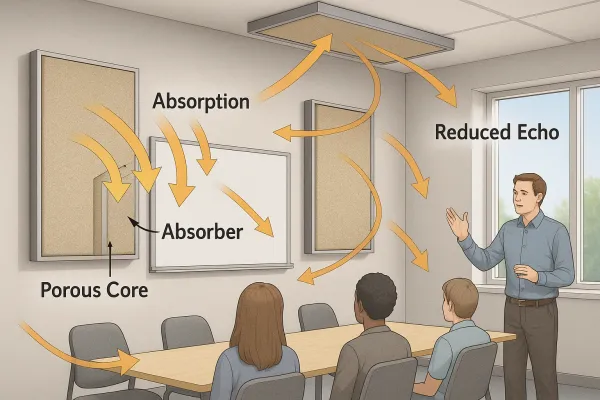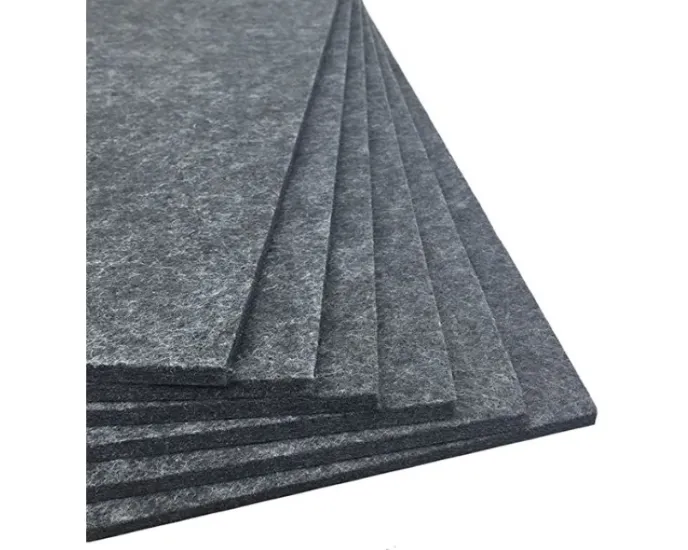Als het antwoord op je vraag op zich laat wachten, voer dan je WhatsApp/Skype in samen met het bericht, zodat we meteen contact met je kunnen opnemen.
Je krijgt binnen 24 uur antwoord. In dringende gevallen kun je WhatsApp/WeChat toevoegen: +86-13678899682.
Are you battling noise and hoping akoestisch fixes will finally bring peace? You’re not alone. Noise leaks, echo, and distraction hurt work and wellbeing. Let’s clear up what akoestisch paneel products do—and what geluiddicht systems do—so you can choose the right solution.
Acoustic panels don’t block sound both ways. They absorb sound to reduce echo and improve sound quality, but they do not stop sound transmission through walls. For true soundproofing, you need added mass, airtightness, and decoupling, not just panels.
We manufacture PET and wood akoestisch panels in China for global B2B projects. Below, we explain how akoestisch en geluiddicht systems differ, when each is useful, and how to combine them for real-world results. You’ll also find practical tables, simple rules of thumb, and field-proven guidance from large commercial and public projects we supply worldwide.
Akoestisch panels are decorative wandpanelen or ceiling elements that absorberen sound. When sound hits them, geluidsenergie is converted—mostly sound energy into heat—reducing the amount that would otherwise bounce around the room. This function is to absorb sound, not block it like masonry or laminated partitions.

What is an acoustic panel and how does it work?
Typical akoestische panelen worden gemaakt from dense polyester (PET), mineral fiber, timber slats on backing felt, or akoestisch schuim. Because these panelen zijn ontworpen with porous cores and micro-air paths, sound is absorbed as pressure waves enter the material. In simple terms, acoustic panels are designed to reduce reflections and reverberation so speech is clearer and meetings run smoother.
In practice, panels are designed to absorb mid to high frequencies (speech range) very efficiently. At low frequencies (HVAC rumble or bass), you need special deep absorbers or tuned traps. Still, panels reduce flutter echo and harshness fast, which panels can make offices, classrooms, and lobbies feel calmer.
As a factory supplier, we tailor thickness, density, and perforation so akoestische prestatie matches your room goals.
Explore material options: PET akoestische panelen en Houten akoestische panelen.
Many teams wonder if panels work both ways—that is, do they stop noise in both directions? In a word: no. You’ll often see the myth that soundproof panels work both ways, but akoestische panelen niet block. They panels primarily absorberen reflections inside a room, lowering the overall amount of noise that escapes. But they do not block noise transmission through a wall.
Think of it this way: acoustic treatment controls reflections binnen een kamer en inside the room; soundproofing slows geluidsoverdracht through barriers. Because absorption lowers the in-room sound level, panels can reduce how much escapes, but they are not designed to block structure-borne or airborne transfer.
For deeper detail on project integration, see our akoestische behandeling ideas and slat options in PET lamellenpanelen.
Geluiddicht assemblies (walls, doors, floors) are designed to block transfer by combining mass (e.g., drywall layers), damping, airtight seals, and often materialen zoals resilient channels for decoupling. They block sound transmission en geluid tegenhouden adjacent rooms. They are your echte geluidsisolatie backbone.
By contrast, akoestisch products geluidskwaliteit verbeteren by reducing reflections. They tame echo, they do geluidsreductie in the talk zone, and they het geluid verbeteren of speech and music, but they don’t block external noise by themselves. Soundproofing requires construction-layer changes; soundproofing panels depends on mass, seal quality, and continuity.
Use both together for optimal soundproofing:
See our designer-friendly options for front-of-house spaces: Perforated PET Decorative Panels.
Akoestisch schuim is lightweight, easy to mount, and great at taming mid/high reflections. But schuimpanelen don’t block. They’re absorbers. The phrase foam work both ways pops up online, yet acoustic foam works by absorbing—not by stopping transfer through partitions. The same reality applies if you ask whether foam work both ways in halls or offices.
In some installs, foam may slightly reduce what neighbors hear because it lowers in-room level. But again, that’s not the same as a barrier. If you need better soundproofing, adjust the wall build, not just the finish layer. For architectural aesthetics, consider wood-on-PET slats: Houten akoestische panelen.
Absorbers geluidsgolven absorberen as they pass through a porous core. That absorption trims reflections, helps reduce echoen panels improve speech clarity. With fewer reflections, you reduce noise levels from chatter. Effective use will geluidskwaliteit verbeteren in meeting rooms, schools, and venues.

The basics of sound absorption
Key points on geluidsabsorptie:
A typical PET panel (12 mm) vs slat panel (wood veneer over PET felt):
| Product type | Typical thickness | NRC (broadband) | Primary benefit |
|---|---|---|---|
| PET flat panel | 9-12 mm | 0.70-0.85 | echo verminderen for speech |
| Wood slat on PET | 20–25 mm | 0.75–0.95 | Adds design + absorption |
For signature walls that are both decorative and functional, see Engraved V-Slot PET Panels.
Effective projects place akoestische wandpanelen at first-reflection points on muur of plafond, behind talkers, and opposite large glass surfaces. When panels are installed at these locations, they catch early reflections and room by reducing echo you get calmer conversations.
Quick placement rules:
Installation tip: akoestische panelen installeren with a slight air gap (25–50 mm) for deeper absorption efficiency.
To align with interior palettes, acoustic panels come in felts, veneers, and custom colors. Need a consistent brand look? Talk to us about OEM finishes on PET akoestische panelen.
Naar block unwanted noise, add mass (double gypsum), damping membranes, and airtight seals around outlets and doors. To absorb reflections, use acoustic finishes like PET felt and slatted wood. For cost control, combine both: build a good barrier, then finish with absorbers.
Glossary at a glance:
About “foam barriers”: Despite marketing phrases like soundproofing foam work, foam isn’t a wall. It’s a finish. Plan barriers first, then select acoustic panels and acoustic foam to fine-tune the space.

PET-vilt
A 1,200 m² open office had external noise from a café and a corridor. We supplied PET and wood-slat akoestisch finishes. Adding 35% wall coverage near collaborative zones plus ceiling baffles cut RT60 by ~40%. That lowered geluidsniveaus and raised speech privacy perceived by staff.
Important note: acoustic panels may reduce what neighbors hear because the in-room level drops, but they do not block external noise on their own. For adjacent room privacy, upgrade the partition and add seals. Then use akoestisch finishes to tune the space. See finish options in Technical Wood Veneer Panels.
Absorbers reduce reflections and chatter; they don’t stop geluid van binnenkomen of verlaten. To prevent noise from entering or leaving a room, build better partitions. That means sealed doors, continuous mass, resilient channels, and damped layers. After that, add akoestisch finishes to polish speech clarity.
Think in layers:
If your goal is to geluid tegenhouden a meeting room, treat the wall assembly—not just the finish. For finishes that keep the brand look while tuning acoustics, explore Perforated PET Decorative Panels.
Set expectations clearly with stakeholders. Absorbers deliver fast comfort wins and geluidsbeheersing for speech; barriers deliver privacy. Combining both brings best soundproofing solutions at scale.
Project checklist:
Onthoud: acoustic panels cannot fix a leaky door frame, and akoestische panelen niet seal electrical boxes. Soundproofing requires construction upgrades; finishes then refine the experience. Need help scoping soundproofing solutions from schematic to install? Our engineering team can assist.
| Doel | Solution Type | Wat het doet | Opmerkingen |
|---|---|---|---|
| Speech clarity | Akoestisch PET/wood panels | Absorb reflections; absorbing excess sound | Choose thickness and coverage by room size |
| Privacy between rooms | Mass + damping + seals | Block noise transfer | Specify STC targets; seal doors & penetrations |
| Echo control in glass atriums | Ceilings + walls | panels can reduce nagalm | Combine baffles + wall coverage |
| Low-frequency control | Deep absorbers | Target bass build-up | Corner traps or thick cavities |
If you can still see daylight around a door, you don’t have a sound barrier. Fix the leaks first, then finish the space. That’s how you get better soundproofing en a pleasant, usable room.
Do acoustic panels block sound both ways?
No. Absorbers tame reflections in the treated space; barriers handle privacy. If you need sound stopped entering or leaving a room, upgrade the wall/door assembly first, then finish with absorbers.
Can acoustic panels stop music from a next-door studio?
They might lower in-room loudness, but they won’t stop external noise from entering by themselves. Meeting your goal depends on the wall’s STC and sealing.
Will acoustic foam soundproof my apartment?
Foam reduces echo; it doesn’t seal gaps or add mass. Use a real barrier to slow transfer, then absorbers to tidy reflections.
Where should I start on a tight budget?
Seal doors and penetrations (barrier), then add targeted absorbers at first reflections. This brings big returns with modest cost.
What makes a good soundproof wall?
Mass (two layers of drywall), damping (viscoelastic compound), decoupling (resilient channels), and airtightness throughout.
Do you customize panels for brand projects?
Yes—OEM/ODM colorways, sizes, slat spacing, fire ratings, and CNC patterns to match design intent, schedules, and logistics.